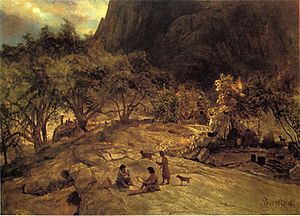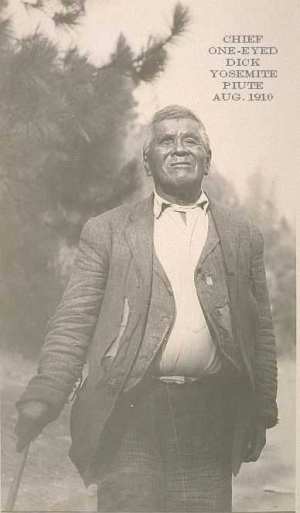Ahwahnechee facts for kids

The Ahwahnechee (say "Ah-wah-NEE-chee") are a group of Native American people. They traditionally lived in the beautiful Yosemite Valley in California. Today, many still live in the areas around the valley. They are connected to the Miwok, Northern Paiute, and Kucadikadi Mono Lake people. The Ahwahnechee are one of the most studied Native American groups. Their history and culture are an important part of Yosemite National Park.
Over time, their name was written in different ways by European-Americans. Some of these names included Ahwahnechee, Awalache, Awallache, and Awanee.
Contents
History of the Ahwahnechee People
The Ahwahnechee people lived in Yosemite Valley for a very long time. It is believed they have been there for as long as 7,000 years. Historians from the National Park Service say they were mainly Southern Miwok people. Other related Miwok tribes lived to the north, south, and west. The Ahwahnechee often traded with the Paiute and Mono people who lived across the mountains to the east. They also married people from these tribes.
First Meetings with European-Americans
European-Americans first arrived in the area after 1833. In 1850, a settler named James D. Savage set up a mining camp. He spent his time looking for gold and trading with other white men. Savage married several Native American women. This helped him build strong relationships with nearby tribes.
Later that year, the Ahwahnechee attacked Savage's camp. Savage had moved onto their land. This upset the Ahwahnechee people. They raided his supplies and killed two of his men. This event started the Mariposa Indian War in 1850 and 1851. In 1851, during this war, California State Militia troops burned Ahwahnechee villages. They also took their food supplies.
The state militia, led by Major Savage, and government officials tried to make treaties with the Native Americans. Six tribes agreed to move to reservation land. But the Ahwahnechee refused to meet. When soldiers moved to force them out, their chief, Chief Teneiya, appeared alone. He tried to hide where his people were and how many there were.
Major Savage told Chief Teneiya he would go into the valley to find his people. Chief Teneiya said he would return with his tribe. When the chief came back, Savage noticed only a few people were with him. He asked where the rest of his people were. Chief Teneiya said he had no more people. Savage believed he could convince the rest of the tribe to come to negotiations.
The Major took some men and traveled north through the mountains. They came upon the valley. This was the first time white men entered Yosemite Valley. That night, the men decided what to name the valley. They agreed on the name "Yosemite," which was what white men already called the tribe. This happened on March 25, 1851. When they reached Chief Teneiya's village, they found no more Native Americans. The soldiers returned, but Chief Teneiya and the part of the tribe they had escaped. They went back to the mountains.
That May, a second group of militia went north to capture the old chief and his group. They found only a few warriors, including two of Chief Teneiya's sons. The chief was eventually brought in. He learned that his sons had been killed while trying to escape. A few days later, the chief also tried to escape by jumping into the river.
After Chief Teneiya was recaptured, the rest of his group was found easily. They were taken to the Fresno reservation. They stayed there long enough to get their strength back. Then they asked to return to their mountain home. This was allowed, and they went back to their valley, which they called “Ahwahnee.”
In 1852, a group of US federal troops heard that Ahwahnechee people had killed two European-American miners. Soldiers were sent again. The troops killed five Ahwahnechee men. Later, the tribe fled over the mountains to stay with the neighboring Mono tribe. They stayed for a year. Then they returned to their valley. They took horses stolen from the Mono people. The Mono people soon followed, seeking revenge. They killed Chief Teneiya and all but eight young warriors. They also took all the women and children captive.
Later History of the Ahwahnechee
Chief Teneiya (who died in 1853) was an important leader in Yosemite Valley. His father was Ahwahnechee. He led his group away from Yosemite to live with the Paiute people in eastern California. Chief Tenaya has descendants living today.
The US federal government has moved Yosemite Native people out of the park several times. This happened in 1851, 1906, 1929, and 1969.
Jay Johnson, who is said to be an Ahwahnechee leader in the Mariposa Indian Council, is working to get official federal recognition for the Miwok Indians.
How the Ahwahnechee Used Plants
The Ahwahnechee people used controlled burns in Yosemite Valley. This helped clear out small plants and keep the oak trees healthy. Acorns were a very important food for them. Acorns from the California black oak made up almost 60% of their diet.
They would take acorns from a large storage area. Then they would lay them on a flat rock in the sun to dry. Once dry, the acorns were ground into a fine powder. They used small holes in large granite slabs, like a mortar and pestle. This acorn "flour" was then put into a shallow dip near the river. This dip was lined with ferns to keep the flour from getting lost in the sand. Rocks were heated in a fire and placed into the dip with the acorn flour. This heated and boiled out the bitter taste, making it good to eat. When it was ready, the flour, now a mush, was put into willow cooking baskets. It was heated over a fire and eaten as mush or baked into a flat bread.
A park naturalist named Will Neely made a list of plants the Ahwahnechee commonly used.
- Food: California black oak, sugar pine, western juniper, canyon live oak, interior live oak, foothill pine, buckeye, and pinyon pine nuts provided acorns and seeds. Other plants gave smaller seeds.
- Edible Bulbs and Roots: Mariposa tulip, golden brodiaea, common camas, squaw root, and Bolander's yampah.
- Greens: broad-leaved lupine, common monkey flower, ... buckwheat, California thistle, miner's lettuce, sorrel, clover, umbrella plant, crimson columbine, and alum root.
- Berries and Fruits: Strawberry, blackberry, raspberry, thimbleberry, wild grape, gooseberry, currant, blue elderberry, western choke cherry, Sierra plum, and greenleaf manzanita.
The Ahwahnechee also made drinks from whiteleaf manzanita and western juniper.
- Medicine Plants: Commonly used medicine plants included Yerba santa, yarrow, giant hyssop, Brewer's angelica, sagebrush, showy milkweed, mountain dogbane, balsamroot, California barberry, fleabane, mint, knotweed, wild rose, meadow goldenrod, mule ears, pearly everlasting, and the California laurel.
The tribe used soap plant and meadow rue to make soap. They used strong fibers from Mountain dogbane, showy milkweed, wild grape, and soap plant to make ropes and cords.
Baskets were woven from thin strips of wood. These came from American dogwood, big-leaf maple, buckbrush, deer brush, willow, and California hazelnut. They would add bracken fern for black colors and redbud for red colors in the baskets.
The tribe made bows from incense-cedar and Pacific dogwood. They also built their homes using Incense-cedar wood.
Ahwahnechee Dwellings
The Ahwahnechee people lived in camps at the bottom of the valley. Their homes were called o-chum. These small huts were built with pine wood for the frame and supports. The wood was set up like a teepee, about twelve feet wide. For insulation, cedar bark covered the pine poles. This made a strong and lasting cover for the family inside.
There were two openings in the huts. One was large enough to be an entrance. The other was a small opening at the top of the teepee. This allowed smoke to escape from fires inside. A small fire was built in colder months for warmth. These o-chum huts could house a family of six people. For bedding, the natives often used the skins of small animals. The mattress was made from the skins of larger animals like bear and deer. Blankets were made from strips of smaller animal skins woven together for extra warmth.
Another type of building the Ahwahnechee used was a sweat house. These structures were similar to the o-chum. However, the top was rounded instead of pointed. The entire building was covered with mud. Young hunters used sweat houses before a trip. This helped them get rid of human smells that might scare away prey. Sweat houses also helped men relax and cleanse themselves for religious and health reasons.
Hunting Practices
The Ahwahnechee people hunted many different animals. Deer were one of the animals they hunted.
Ahwahnechee Place Names in Yosemite Valley
The Ahwahnechee people had their own names for places around Yosemite Valley. Here are some of them:
- Ahwahne: Yosemite Valley
- Tesa'ak (Teh-sa-ahk'): Half Dome (South Dome) - This name came from a Mono woman. Half Dome looked like a Mono woman's head and shoulder. Mono women traditionally cut their hair short with bangs. The dark vertical lines of lichens looked like tear stains. People said her tears formed Mirror Lake.
- Loya: Sentinel Rock
- Tutocanula or Tool-tock Awn-oo-lah: El Capitan
- Ahwayee: Mirror Lake
- Patillima or Ernating Lawootoo: Glacier Point
- Pohono: Bridalveil Fall
- Piwyack: Tenaya Lake
- Yonapah: Vernal Fall
- Yowihe: Nevada Fall
- Chookoneh: Royal Arches (Yosemite)
- Tokoyee: North Dome
- Wakalmata: Merced River
- Tahachee: Indian Canyon
- Yayan: Cascade Falls
- Yawachkee: Yosemite Museum - This was the name of the village where the museum is now.
- Mahtah: Liberty Cap
Ahwahnechee Villages
When European settlers first arrived, there were 9 Ahwahnechee villages in Yosemite Valley. About 450 people lived there. By the early 1900s, the population was smaller. The villages included Awani, Hokokwito, Kumaini, Lesamaiti, Macheto, Notomidula, Sakaya, and Wahak. The main village, and the whole Yosemite Valley, was called Awani.
Namesakes
Several places and events are named after the Ahwahnechee tribe. The Ahwahnee Hotel and Ahwahneechee Village in Yosemite Valley are named for them. The village is a recreated 19th-century tribal village. The Ahwahnee Heritage Days are also named after the tribe. The towns of Ahwahnee, California and Ahwahnee Estates, California are also named after the tribe.


